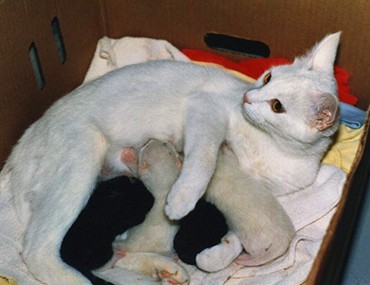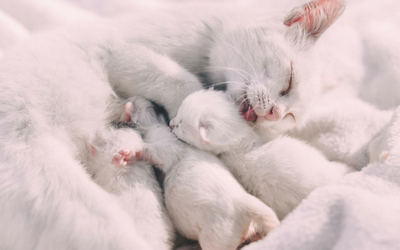mastitis in cats antibiotics
Applying warm compresses to the infected teats helps them to open and drain. Antibiotics such as tetracycline chloramphenicol or aminoglycosides should be avoided during lactation unless the neonates are weaned.
Antibiotics are needed to fight the bacteria that cause the inflammation.

. Hot-packing the affected gland encourages drainage and seems to relieve discomfort. The vet will choose a broad-spectrum antibiotic to carry out the treatment with the most common being the following. Mastitis with infection may be lactational puerperal or non-lactational eg duct ectasia.
Maybe you just heard from your vet that your cat as mastitis or maybe youre researching what may be bugging your cat and came across cat mastitis Either way this problem can really bother cats unlucky enough to suffer from it. Causes of non-infectious mastitis include idiopathic granulomatous inflammation and other inflammatory conditions eg foreign body reaction. Your veterinarian may recommend hand-milking the infected gland.
This treatment is ideal as it allows the cat to remain at home with her kittens. Severely or chronically affected glands may need to be removed mastectomy If systemically ill or septic intravenous fluids would be necessary Home Care and Prevention. It is important to apply warm compresses to the affected area and strip out all milk from the affected glands several times a day.
In some mild cases applying warm compress and putting the cat in antibiotic treatment help resolved the condition. Treatment cost largely depends on the severity of your cats mastitis. AutoShip Save 5.
After being diagnosed mastitis is a treatable condition. Up to 8 cash back Mastitis in Cats Treatment Apply warm moist packs twice a day and express the gland to draw out some of the coagulated milk to keep the gland open. Antibiotics are often prescribed to treat the bacterial infection.
Fluid therapy is indicated in animals with septic mastitis that are dehydrated or in shock. Reducing the queens food intake will stop milk production for queens with no kittens. Treatment Treatment will depend on the severity of the mastitis and the needs of mom and her kittens.
Timely management of mastitis with antibiotics can help avoid complications. There is an urgent need to conduct high-quality double-blinded RCTs to determine whether antibiotics should be used in this common postpartum condition. Your veterinarian may recommend hand-milking the infected gland.
Most cats with mastitis can be treated on an outpatient basis with oral antibiotics and pain medications. 1 Special medicated wipes may be recommended by your veterinarian and antibiotics probiotics pain medications and anti-inflammatory medications may also be prescribed to treat the infection and its symptoms. Cats with severe mastitis need to be treated with intravenous fluids and aggressive antibiotic therapy in the hospital.
Ad Save 50-70 on Pet Meds Today. Easy Refills with Autoship. Treating and preventing mastitis will.
What antibiotics treat mastitis in cats. Your veterinarian will prescribe an appropriate antibiotic. This treatment is ideal as it allows the cat to remain at home with her kittens.
Kittens may need to be supplemented with formula while their mom is being treated. This treatment is ideal as it allows the cat to remain at home with her kittens. Amoxicillinclavulanate is considered a safe first choice as it penetrates and concentrates in milk and is safe for nursing puppies and kittens 12.
This can alleviate discomfort while also encouraging blood flow and promoting healing. Cooling compresses can provide additional relief and reduce the swelling. This can alleviate discomfort while also encouraging blood flow and promoting healing.
Your veterinarian may recommend hand-milking the infected gland. Gangrenous or necrotic glands are cold and darker in color. Mastitis from a bacterial infection is treated with antibiotics and pain medications.
Treating Mastitis in Cats. There is insufficient evidence to confirm or refute the effectiveness of antibiotic therapy for the treatment of lactational mastitis. Treatment of Mastitis in Cats Systemic antibiotic therapy Topical warm water compresses Affected glands should be emptied Glands may need to be surgically lanced or drained.
The recommended oral dose in bitches and queens is 15 mgkg BW q12h for 2 to 3 wk 9. Mastitis occurs when a mammary gland isnt fully emptied and bacteria from the cats bloodstream the environment or the kittens mouths enter into the gland itself and cause an infection. Cephalexin 515 mgkg PO tid and amoxicillinclavulanate 14 mgkg PO bid-tid are recommended as initial therapeutic agents pending culture results.
In cases where the mastitis is quite severe then the cat needs to be hospitalized just like the case mentioned above. Affected breasts with dead mammary tissue require surgical removal. Add your Vet and Pet Rx info then Chewy Handles the rest.
Since antibiotics can pass through your cats milk to the kittens your vet will avoid some types like tetracycline chloramphenicol or aminoglycosides. The compresses can aid in draining out the gland. The wound was checked and cleaned daily and antibiotic was given.
Most cats with mastitis can be treated on an outpatient basis with oral antibiotics and pain medications. Ad Trying Chewy Pharmacy is Easy. Follow your veterinarians instructions on how much and how long to take your sick cats antibiotics and mastitis will usually recover quickly.
Fast Free Shipping Available. Cephalexin 515 mgkg PO tid and amoxicillinclavulanate 14 mgkg PO bid-tid are recommended as initial therapeutic agents pending culture results. Ad Why Pay More for the Same Pet Medications from your Vet.
Treatments your vet will recommend include antibiotics and warm compresses. Most cats with mastitis can be treated on an outpatient basis with oral antibiotics and pain medications. Learning about this painful problem is the first step to helping your cat find relief.
Fluid therapy is recommended if systemic involvement occurs. Amoxicillin Amoxicillin Clavulanic Acid Cephalexin Cefoxitin Treatment will last approximately 2-3 weeks and you can carry it out at home except for those cases where there is a widespread infection or sepsis. Glands may need to be surgically lanced drained or removed entirely mastectomy.
If mastitis is the result of bacterial infection it will need to be treated with antibiotics.

Milk Stasis And Mastitis What To Do Youtube

Mammary Hypertrophy In Cats Reproductive System Merck Veterinary Manual

Feline Mastitis A Bacterial Infection In New Mother Cats

Mastitis In Cats Vca Animal Hospitals

Mastitis In Cats Symptoms And Treatment

Get The Facts About Mastitis In Cats Catster

Get The Facts About Mastitis In Cats Catster
/Stocksy_txp208a3fd2h96200_Medium_725955-5bae79974cedfd0026989305.jpg)

